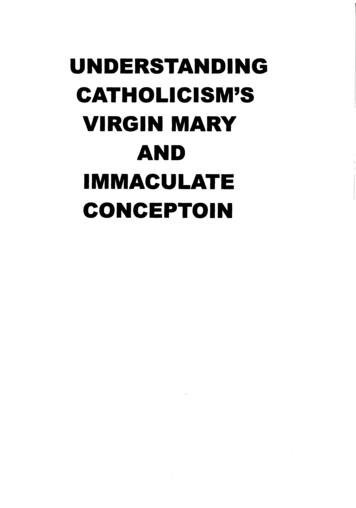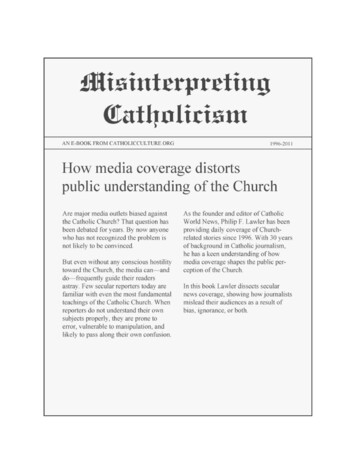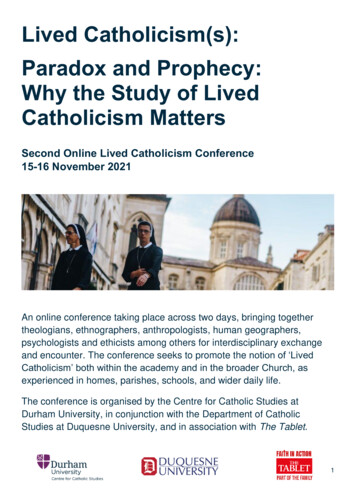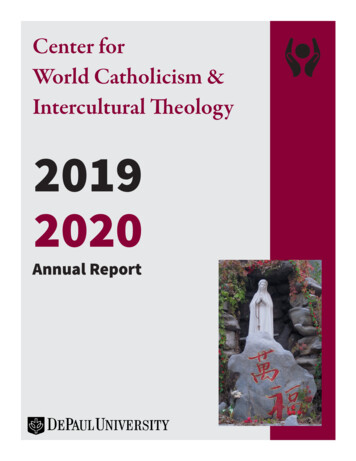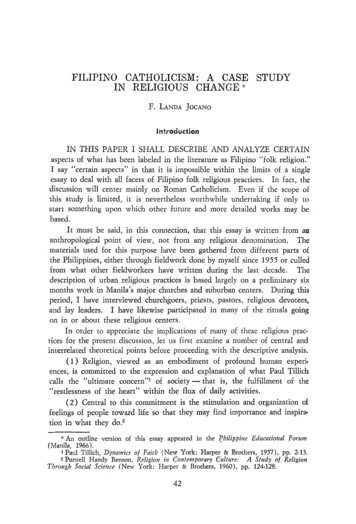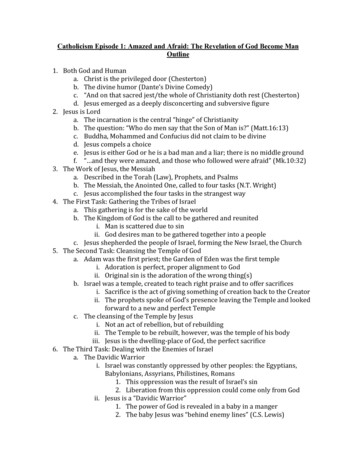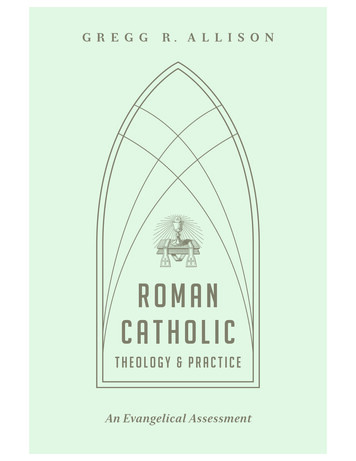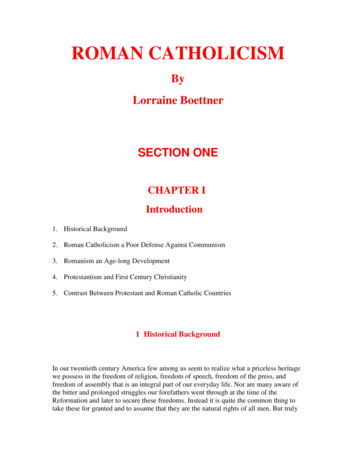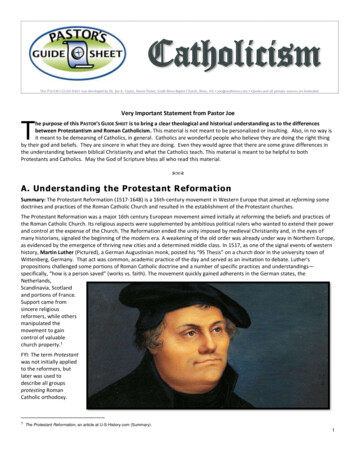
Transcription
fCatholicismThis PASTOR’S GUIDE SHEET was developed by Dr. Joe K. Taylor, Senior Pastor, South Reno Baptist Church, Reno, NV joe@southreno.com Quotes and all primary sources are footnoted.Very Important Statement from Pastor JoeThe purpose of this PASTOR’S GUIDE SHEET is to bring a clear theological and historical understanding as to the differencesbetween Protestantism and Roman Catholicism. This material is not meant to be personalized or insulting. Also, in no way isit meant to be demeaning of Catholics, in general. Catholics are wonderful people who believe they are doing the right thingby their god and beliefs. They are sincere in what they are doing. Even they would agree that there are some grave differences inthe understanding between biblical Christianity and what the Catholics teach. This material is meant to be helpful to bothProtestants and Catholics. May the God of Scripture bless all who read this material. A. Understanding the Protestant ReformationSummary: The Protestant Reformation (1517-1648) is a 16th-century movement in Western Europe that aimed at reforming somedoctrines and practices of the Roman Catholic Church and resulted in the establishment of the Protestant churches.The Protestant Reformation was a major 16th century European movement aimed initially at reforming the beliefs and practices ofthe Roman Catholic Church. Its religious aspects were supplemented by ambitious political rulers who wanted to extend their powerand control at the expense of the Church. The Reformation ended the unity imposed by medieval Christianity and, in the eyes ofmany historians, signaled the beginning of the modern era. A weakening of the old order was already under way in Northern Europe,as evidenced by the emergence of thriving new cities and a determined middle class. In 1517, as one of the signal events of westernhistory, Martin Luther (Pictured), a German Augustinian monk, posted his “95 Thesis” on a church door in the university town ofWittenberg, Germany. That act was common, academic practice of the day and served as an invitation to debate. Luther'spropositions challenged some portions of Roman Catholic doctrine and a number of specific practices and understandings—specifically, “how is a person saved” (works vs. faith). The movement quickly gained adherents in the German states, theNetherlands,Scandinavia, Scotlandand portions of France.Support came fromsincere religiousreformers, while othersmanipulated themovement to gaincontrol of valuablechurch property.1FYI: The term Protestantwas not initially appliedto the reformers, butlater was used todescribe all groupsprotesting RomanCatholic orthodoxy.1 The Protestant Reformation, an article at U-S-History.com (Summary).1
Martin LutherPrecursors to the ReformationJohn WycliffeJohn Wycliffe (1330–1384) attacked what he saw as corruptions within the church, including the sale ofindulgences, pilgrimages, the excessive veneration of saints, and the low moral and intellectual standards ofordained priests. Wycliffe also repudiated the doctrine of transubstantiation, held that the Bible was the solestandard of Christian doctrine, and argued that the authority of the Pope was not grounded in Scripture.Some of Wycliffe's early followers translated the Bible into English, while later followers, known as Lollards, held that the Bible wasthe sole authority and that Christians were called upon to interpret the Bible for themselves. The Lollards also argued against clericalcelibacy, transubstantiation, mandatory oral confession, pilgrimages, and indulgences.John HussJohn Huss (1369–1415) was a Bohemian priest, excommunicated in 1410, and burned at the stake for heresy in1415. His death lead to the Hussite Wars in Bohemia. Huss followed Wycliffe's teachings closely, translatingWycliffe's Trialogus into Czechoslovakian, and modeling the first ten chapters of his own De Ecclesia afterWycliffe's writings. He believed in predestination, regarded the Bible as the ultimate religious authority, andargued that Christ, rather than any Ecclesiastical official, is the true head of the church.Prominent figures in the ReformationMartin LutherMartin Luther (1483–1546), nailed his “95 Theses” onto a Wittenberg Church door in 1517. These theses wereLatin propositions opposing the manner in which indulgences (release from the temporal penalties for sinthrough the payment of money) were being sold in order to raise money for the building of Saint Peter's inRome. (See Appendix A for the complete “95 Theses” translated in English)Huldreich ZwingliHuldreich Zwingli (1484–1531) was a Swiss theologian and leader of early Reformation movements inSwitzerland. He vigorously denounced the sale of indulgences in 1518.John CalvinJohn Calvin (1509–1564) was a French theologian and reformer who fled religious persecution in France andsettled in Geneva in 1536. He instituted a form of Church government in Geneva, which has become known asthe Presbyterian church. He insisted on reforms including: the congregational singing of the Psalms as part ofchurch worship, the teaching of a catechism and confession of faith to children, as well as the enforcement ofa strict moral discipline in the community by the pastors and members of the church. Geneva, under Calvin,was essentially a theocracy.John KnoxJohn Knox (1513–1572), an ardent disciple of Calvin, established Calvinistic Protestantism as the nationalreligion of Scotland. He left a powerful political legacy within the Calvinist or Reformed branch ofProtestantism, known as Presbyterianism.2
Henry VIIIIn 1533, Henry VIII (1491–1547) was excommunicated by the pope for marrying Anne Boleyn and having thearchbishop of Canterbury sanction the divorce from his first wife, Catherine. In 1534, Henry had Parliamentpass an act appointing the king and his successors supreme head of the Church of England, thus establishingan independent national Anglican church.2Theological Issues of the ReformationThe theology of the Reformers departed from the Roman Catholic Church primarily on the basis of three great principles: 3 Sole authority of ScriptureJustification by faith alonePriesthood of the believerSola ScripturaSola Scriptura (by Scripture alone) was one of the watchwords of the Reformation. This doctrine maintains that Scripture, ascontained in the Bible, is the only authority for the Christian in matters of faith, life and conduct. The teachings and traditions of thechurch are to be completely subordinate to the Scriptures. Roman Catholicism, on the other hand, holds Scripture and Tradition tobe of the same inspired Deposit of Faith.Sola FideSola Fide (by faith alone) was the other watchword of the Reformation. This doctrine maintains that we are justified before God (andthus saved) by faith alone, not by anything we do, not by anything the church does for us, and not by faith plus anything else. It wasalso recognized by the early Reformers that Sola Fide is not rightly understood until it is seen as anchored in the broader principle ofSola Gratia (by grace alone). Hence, the Reformers were calling the church back to the basic teaching of Scripture where the apostlePaul states that we are "saved by grace through faith and that not of ourselves, it is the gift of God," Eph. 2:8.Priesthood of all BelieversThe third great principle of the Reformation was the priesthood of all believers. The Scriptures teach that believers are a "holypriesthood," (1 Pet. 2:5). All believers are priests before God through our great high priest, Jesus Christ. "There is one God and onemediator between God and man, the man Christ Jesus," (1 Tim. 2:5). As believers, we all have direct access to God through Christ,there is no necessity for an earthly mediator. The Roman Catholic and Eastern Orthodox concept of the priesthood was seen ashaving no warrant in Scripture and viewed as a perversion and mis-application of the Old Testament Aaronic or Levitical priesthoodwhich was clearly fulfilled in Christ and done away with by the New Testament.As a result of these principles, the Reformers rejected the authority of the Pope, the merit of good works, indulgences, themediation of Mary and the Saints, all but the two sacraments instituted by Christ (Baptism and the Lord's Supper), the doctrine oftransubstantiation, the mass as a sacrifice, purgatory, prayers for the dead, confessions to a priest, the use of Latin in the services,and all the paraphernalia that expressed these ideas.Even though the Roman Catholic and Eastern Orthodox churches fall within Orthodoxy as most would define it, much of theirteaching beyond the basic tenets is regarded as erroneous by conservative Protestants. In fact, they would say much of it is clearly tobe regarded as false teaching which has perverted the gospel of God's grace in Jesus Christ. In general, evangelical Protestants seethe Reformation as simply a call back to biblical Christianity.42 Justo Gonzales, The Story of Christianity: The Reformation to the Present Day, vol. 2. San Francisco: Harper, 2010.3 Eerdmans' Handbook to the History of the Christian Church, Tim Dowley editor, p. 364ff. See also, The New Schaff-Herzog Encyclopedia of Religious Knowledge (1911),s.v. The Reformation, Vol. IX, p. 419.4 Robert Kolb, Confessing the Faith: Reformers Define the Church, 1530-1580. St. Louis: Concordia Publishing, 1991.3
Roman CatholicismB. Understanding Roman Catholicism1. What is considered “Holy” to Catholics?i. The Bible including the ApocryphaThe Catholic church does not specify a specific translation, but does encourage “thematic equivalent translations”(literal translations). Their bible includes the same books as a protestant Bible, but it also contains the Apocrypha(a Greek word, ἀπόκρυφος, “apókruphos”, meaning "hidden"), is written by unknown authors, does not speak toany significant point in Christianity, and is basically historical in nature. Much of what is spoken of in theApocrypha cannot be historically verified.ii. The Words of the PopePapal Infallibility is a dogma (ie., teaching) of the Catholic Church that states that, in virtue of the promise of Jesusto Peter, the Pope is preserved from the possibility of error "when, in the exercise of his office as shepherd andteacher of all Christians, in virtue of his supreme apostolic authority, he defines a doctrine concerning faith ormorals to be held by the whole Church." 5iii. The Traditions of the ChurchThe term "deposit of faith" (Latin: fidei depositum) refers to the entirety of Jesus Christ's revelation, and accordingto Roman Catholic theology, is passed to successive generations in two different but equal forms, sacred scripture(the Bible) and sacred tradition (through the Roman Magisterium). 62. So does Sola Scriptura or the Bible plus tradition really matter?The Issue: One of the major battle cries of the Protestant Reformation and its leaders was sola scriptura (or scripturealone). To Romans Catholics, they believe that the authority of the popes is passed down from Peter to succeeding popes—thus making all popes and their traditions as holy as God’s word.Response: Both Catholics and Protestants believe in the holiness of God’s written Word. The issue is whether the pope’sauthority is biblical (passed down Peter) or not. Catholics based this doctrine on a single passage - Matthew 16:13-20. Inthis passage, Jesus paused to ask his disciples, “Who do you say that I am?”. Peter tells Him that He is the Christ, the Son ofthe living God. Jesus tells Peter that only His Father in heaven could have revealed this theological truth to him (Peter),then adds these very significant lines:Matthew 16:16–17, NASB95 - 16 Simon Peter answered, “You are the Christ, the Son of the livingGod.” 17 And Jesus said to him, “Blessed are you, Simon Barjona, because flesh and blood did notreveal this to you, but My Father who is in heaven. 18 “I also say to you that you are Peter [Gk: Πέτρος,“Pet-ROS” lit., a small stone”], and upon this rock [Gk: πέτρα, “PET-ra” lit., a ledge of rock] I will build My church; andthe gates of Hades will not overpower it. 19 “I will give you the keys of the kingdom of heaven; andwhatever you bind on earth shall have been bound in heaven, and whatever you loose on earthshall have been loosed in heaven.”The Greek text clearly refers to Peter as Petros (meaning a small stone) and to “this rock” as Petra (meaning a very largeledge of rock.) Protestant scholars believe that the “rock” mentioned by Jesus in this passage was the confession that Petermade (“You are the Christ, the Son of the living God”) and not Peter Himself.Very Important: When the New Testament speaks of the Churches’ foundation it always clearly identifies Christ at thatfoundation, and no one else (cf., 1 Cor. 3:11; Eph. 2:20; 1 Peter 2:4-8 among many other verses). There are no otherScriptures that even hint that Peter—or any other person—is the foundation of the church. 75 "Infallibility means more than exemption from actual error; it means exemption from the possibility of error," P. J. Toner, Infallibility, Catholic Encyclopedia, 1910, p. 135.(Quoting "Pius IX Vatican I". Ewtn.com. Retrieved 2016-12-21.)6 Ibid., Pius IX Vatican 1, pp. 146-147,7 Ridenour, Fritz, So What’s the Difference, Ventura, CA: Regal Books, 2001. Pp. 38-39.4
This passage begins with this important phrase:Matthew 16:13, NASB95 - 13 Now when Jesus came into the district of Caesarea Philippi, He was askingHis disciples, “Who do people say that the Son of Man is?”Observe where this discussion between Christ and His disciples took place and one can realize even further what Christ really meant.The large cave is called “The Grotto of Pan.” As early as the 3rd century BC, many pagan (false) religions believed this was the “gatesof hell.” One can also see the large ledge of rock in the background. What if Christ had picked up one of the many small stones(Peter) and pointed to the ledge of stone (Petra) when He said “Upon this rock (Peter’s confessions), I will build My Church? WhenHe referenced “the gates of hell”, He might have very well pointed to the cave in this picture.Very Important: A picture should not be what we build a theological belief on—only the Word of God. The picture above is meantonly to bring life to the text. The relationship between Greek words and what they modify is called “periphrastic construction” (alinguistic process that might be a little deep for those not trained in Biblical Greek). A clear understanding of the theological aspectsof this passage (syntax, geography, periphrastically, exegetically), and an even cursory understanding of the Old and NewTestaments, as a whole, points to Christ—not Peter—being the foundation of the church.Christ—not Peter—is the foundation of the church.5
FYI: According to the Catechism of the Catholic Church, Jesus named Peter the “rock” of His church and gave Peter the ‘keys’and made him—and all succeeding popes—shepherd of the whole flock.“This pastoral office of Peter and the other apostles belongs to the Church’s very foundation and is continued by thebishops under the primacy of the Pope [who is] Vicar of Christ and as pastor of the entire Church has full, supremeand universal power over the whole church, a power which he can always exercise unhindered.” 8Conclusion: Nowhere else is Peter referred to as the foundation of the church—only Christ. Nowhere does Scripture referto the church as “holy.” Sola scriptura does not mean anyone can believe whatever he/she likes and interpret the Bible asthey see fit. The believer must insist that the church stay true to the Holy Word of God. Therefore, God’s Holy word—notthe traditions of the church—are the sole standard for the church, its ministry, its polity, and its existence. The church isnot truth per se; it is called to teach the truth and the church must remain subservient to the truth which is God’s HolyWord and nothing else. His Holy Word—not traditions, leaders, clergy, laity, etc.—is the sole standard of authority in allmatters.3. Are we saved by faith alone or by works?Protestants believe in sola scriptura (the Bible alone) for the source of final authority and truth. Protestants also believe insola fide (Faith alone) for their source of salvation. Catholics believe that the Christian must rely on “faith plus good works”and God’s grace mediated through the Seven Sacraments (something they ‘do’).The Seven Sacraments of the Catholic Church are as follows:Baptism – Infants, or adults must be baptized. This imparts sanctifying grace and erases original sin. A Catholickeeps sanctifying grace active in their lives only through “spiritual battle” (following the program of good works.) 9Confirmation – This event builds on baptism and is given after a brief study of spiritual things by the Catholicchurch. In this event, the priest “blesses” the candidate with the “gift of the Holy Spirit”. (It typically happens atage 12.) It is not based on Scripture—only on tradition.Holy Eucharist (Holy Communion) – This is the most important sacrament of the Catholic Church. Administeredthrough the mass, the holy Eucharist is a miracle of transubstantiation, where the bread and wine literally becomethe flesh and blood of Christ. In this act, Christ is re-present as a sacrifice for sins committed by the Catholic.Penance (Confession) – A Catholic will come before their priest to confess and receive forgiveness of their sins. Itcompletes what the Holy Eucharist begins. The priest will assign a “penance” for the Catholic to perform in orderto demonstrate his/her sincerity and earn forgiveness (eg., prayers, acts of service, restrictions, payments, etc.)There are two types of sins in Catholicism: Mortal Sins which are very grace offences committed “with full knowledgeand deliberate consent” and will result in the “loss of sanctifying grace” and will cause the person to “be excludedfrom Christ’s kingdom and be “sent to an eternal hell.”10 Examples of “mortal sins” are blasphemy, adulterer,fornication, stealing, murder, drunkenness, and/or homosexuality. Venial Sins are less serious sins and can be easilyforgiven. A venal sin will weaken the Catholics faith, but would not result in the loss of sanctifying (saving) grace.11Examples of venial sins are white lies, overeating, going a few miles over the speed limit, etc.Anointing of the Sick – (formally called Extreme Unction and is sometimes referred to as Last Rites.) The Priest willlay hands on the sick or dying person, pray over him or her in faith of the Church and anoints the believer with oil.Usually done by the bishop (but can be done by a priest and in rare cases, by a deacon).Holy Orders – A sacrament through which Catholic ministers are ordained at one of three levels: bishops, priestsand deacons. Only bishops can confer the Sacrament of Holy Orders (there is no exceptions).Matrimony – is the sacrament in which Christ—via the church—joins a Christian man and woman in holy marriage.Divorce and remarriage cut the Catholic off from the Eucharistic communion, but not from the church.FYI: Protestants believe that one believer or even the church cannot absolve another believer’s sin. Only Christ’sblood can do that. The believer’s connection to God need not be mediated by a priest or anyone else for Christand Christ alone is the “one mediator” between God and man (1 Timothy 2:5). Also, many Protestants believe‘sacraments’ described on this page may be “good acts” but they are not “saving acts”.8 Catechism of the Catholic Church, paragraphs 881-882.9 Catechism of the Catholic Church, paragraph 405.10 Catechism of the Catholic Church, paragraphs 1857-1861.11 Catechism of the Catholic Church, paragraphs 1862-1863.6
To be fair, Catholics do not believe they are “saved by works” alone. They do believe in the blood sacrifice of Jesus Christ.They only state that the blood of Jesus and what He did on the cross is not enough. 12 For Catholics, faith in Christ is thebeginning of salvation and lays the foundation for justification. They then build on that foundation because “ man has tomerit God’s grace of justification and eternal salvation.”13 Protestants disagree as they see the process of justification asnot being achieved by something man does, but because of something Christ did on the cross. One is not made righteousbut declared righteous by Christ.Conclusion: Protestants teach that people are declared righteous in God’s sight for only one reason—their professed faithin Christ and what He did for them on the cross (cf., Rom. 3:21-5:21; 10:4; 1 Cor. 1:30; Phil 3:9). The believer is given thegift of righteousness as a gift apart from human merit or works. Works (ie., sacraments) has no role in the salvationprocess.Ephesians 2:8–9, NASB95 - 8 For by grace you have been saved through faith; and that not ofyourselves, it is the gift of God; 9 not as a result of works, so that no one may boast.4. What is purgatory all about?The Catechism of the Catholic Church defines purgatory as a "purification, so as to achieve the holiness necessary to enterthe joy of heaven," which is experienced by “those who die in God’s grace and friendship, but still imperfectly purified." 14It notes that "this final purification of the elect . . . is entirely different from the punishment of the damned.” 15 Thepurification is necessary because, as Scripture teaches, nothing unclean will enter the presence of God in heaven (Rev.21:27) and, while we may die with our mortal sins forgiven, there can still be many impurities in us, specifically venial sinsand the temporal punishment due to sins already forgiven.Bottom line, purgatory is a special place of cleansing where payment for sins is completed and believers are made fit forheaven. It’s not hell—eternal domination; it’s not heaven—eternal rest. It’s purgatory—a temporary place where a soulsubmits to a purification process until all sins are atoned for. Purgatory is commonly regarded as a place of cleansing byway of painful, temporal punishment and/or works.5. What are indulgences all about?The Catechism of the Catholic Church (CCC) teaches that those in purgatory most likely face a long process of purification.The CCC also teaches that fellow Catholics still living on Earth can assist those in purgatory to obtain heaven more quicklyby praying for them, offering Mass for them and doing forms of good works, which includes gaining indulgences. Accordingto the Catechism, those seeking indulgences want to shorten their own or someone else’s time in purgatory. In the middleages, indulgences became corrupt and amounted to little more than an offering—or a “payment” for sins. Though afinancial gift may be a form of indulgences today, it will most like be accompanied by works, as well.Acts of indulgences can include prayers/rosaries (formal prayers), reading of scripture, acts of service to the church, visitingthe stations of the cross, masses, repeated prayers to the saints, repeated prayers to the Virgin Mary.6. What is a rosary?Pope Leo XIII, known as "The Rosary Pope", issued the basic guidelines of these formal prayers. 16 The prayer holds a set ofrosary beads and when prayers are repeated, they move to the next bead. It is a way of numbering the prayers withoutfocusing on counting. All rosary prayers are said to the Virgin Mary. The standard fifteen Mysteries of the Rosary (specificprayers to Mary), may be followed by "The Lord's Prayer" (x7), a “Hail Mary" (x10) prayer, and sometimes a "Magnificat"(x7) prayer. When referring to the beads, it is normally written with a lower-case initial ("a rosary"). When referring to theprayer process, the word Rosary is capitalized.12 Catechism of the Catholic Church, paragraph 1993.13 Mario Colacci, The Doctrinal Conflict between Roman Catholic and Protestant Christianity (Minneapolis, MN: T. S. Denson and Co., Inc 1962, pp. 140-142,14 Catechism of the Catholic Church, paragraphs 1030.15 Catechism of the Catholic Church, paragraphs 1031.16 John Paul II (October 16, 2002). "Rosarium Virginis Mariae: On the Most Holy Rosary". Archived from the original on 30 June 2016; Vatican Archives.7
7. What a Mariolatry (the worship of the Virgin Mary)?The Bible says that the Virgin Mary is high favored and blessed among women (Luke 1:28). Protestants believe thatCatholics have taken Mary from “blessed” to “co-mediator” with Christ. Special honor for the Virgin Mary becamecenturies ago in Catholicism and has become what many Protestants believe is pure and simple worship of Mary. Catholicsresponsd to this criticism by pointing out the three levels of worship in their theology: 17Three Levels of Worship in CatholicismLatriaHighest level of worshipReserved only for God the Father, God the Son andGod the Holy Spirit. Also calledsupralapveneration or super-hyper honor.HyperduliaMiddle level of worshipReserved for Mary and Mary alone in which she isgiving hyperveneration or hyper honor.DuliaLowest level of worshipVeneration (honor) due the angels, saints andcanonized saints.The different levels of worship argument (above) really doesn’t rebuff the criticism that Catholics worship Mary. Beginningin the early centuries, different popes (via papal encyclicals) referred to Mary in different ways; “Mediatrix” or co-mediatorwith Christ between God and man; “Redemptrix” or co-redeemer with Christ and others.“As no man goeth to the Father but by the Son,so no man goeth to Christ but by His mother.”- Pope Leo XIII (circa 1891)18There are other doctrines in Catholicism that grew out of a worship of Mary:The Doctrine ofPerpetual VirginityThe Catholic belief that Mary never lost her virginity even after the birth ofChrist and that she had no more children. (Pope Pius IX)The Doctrine ofImmaculate ConceptionThe Catholic belief that Mary, at her conception, was sinless and lived a lifewithout sin—like Christ. (Pope Pius IX)The Doctrine of DivineTransportationThe Catholic belief that Mary gave birth in a supernatural way. The deliveryof Christ was not vaginal (natural) but Christ simple appeared by her side,thus preserving the evidence of virginity. (Pope Pius VI)The Doctrine of DivineAssumptionThe Catholic belief that Mary did not die a physical death, but “ascended”,like Christ did, directly to heaven. (Pope Pius XII)For Protestants, Pope Leo’s statement (above) and Catholic doctrines and practices certainly encourages Catholics to putMary on too high a pedestal. It also definitely obscures Christ’s function as the sole and unique mediator between God andman.For there is one God, and one mediatoralso between God and men, the man Christ Jesus .- 2 Timothy 2:5, NASBTo be completely fair to our Catholic friends, Vatican II documents claim that special titles for Mary neither take away nor addanything “to the dignity and efficacy of Christ the One Mediator.” 19 For Protestants, the official conclusions of Vatican II don’tseem to align with their teachings and practices.17 Mario Colacci, The Doctrinal Conflict Between Romans Catholic and Protestant Christianity, (Minneapolis, MN: T.S. Denison and company, Inc., 1962.) pp. 140-142 and157ff.18 Pope Leo XIII, Encyclical of September 22, 1891. Paragraph 3, Line 3 (cf., “The pope’s conclusion about the Virgin Mary”).19 Pope Leo XIII, Encyclical of September 22, 1891. Paragraph 1, Line 8 (cf., “Mary is this glorious Intermediary”).8
8. What about transubstantiation?Catholics believe that when the Holy Eucharist takes place, the elements (the bread and wine) actually become the bloodand body of Christ. In, The Faith of Millions, Father John O’Brien states, “When the priest pronounces the tremendousword of consecration, he reaches up into the heavens, brings Christ down from His throne, and places Him upon our altar tobe offered up again as the Victim for the sins of man the priests speaks and lo! Christ, the eternal and omnipotent Godbows His head in humble obedience to the priest’s command to occupy His place in the elements.”Most Protestants believe in a Memorial View (Baptists) of the Lord’s Supper, when we “remember” what Christ did on thecross. In the Memorial view, Christ is not present in the elements—they only memorialize what Christ did.Some Protestants take a Consubstantiational View (more liturgical groups like Presbyterians, some Lutherans, etc.) say theelements have “God’s presence is a unique way” but Christ is not physically present, as Catholics teach.9. Summary of Major Differences Between Catholic and Protestants:1. The Issue of AuthorityCatholics claim that (1) Scripture, (2) Sacred Tradition and the (3) the words of the popes are equal in authority.They also believe the church represents these entities and that the Catholic church, alone, has been entrusted tointerpret the Bible for Catholics who are not to interpret it for themselves.Protestants believe the Bible is the sole guide for faith and practice.2. The Issue of SalvationCatholics claim that salvation is secured by faith in Christ plus good works, and grace conferred through the sevensacraments of the church.Protestants believe that salvation is by sola fide (faith alone) in Christ and His sacrificial death on the cross.3. The Issue of AccessCatholics believe they can only have access to Christ through the church, specifically the priestly system and holysacraments (Priesthood of the priest).Protestants believe they can have direct access to Christ (Priesthood of the believer).10. Final Thoughts:My primary issue with any religious institution thatpromotes a “works-based” means of being saved is thatChrist’s blood and His Word was not enough.– Pastor JoeTragically, some people believe they are going to heaven when they diejust because a few drops of water were sprinkled over their heads a fewweeks after their birth. They have no personal faith, have never made apersonal decision, and are banking on a hollow ceremony to save them.How absurd!– Max Lucado9
A P P E N D I XThe 95 ThesisBy Martin Luther(Circa 1517) 1.2.3.4.5.6.7.8.9.10.11.12.13.14
1 f Catholicism This PASTOR’S GUIDE SHEET was developed by Dr. Joe K. Taylor, Senior Pastor, South Reno Baptist Church, Reno, NV joe@southreno.com Quotes and all primary sources are footnoted. Very Important Statement from Pastor Joe he purpose of this PASTOR’S GUIDE SHEET is to bring a clear theological and histor

